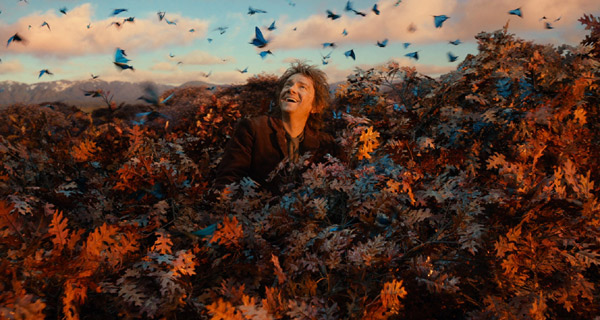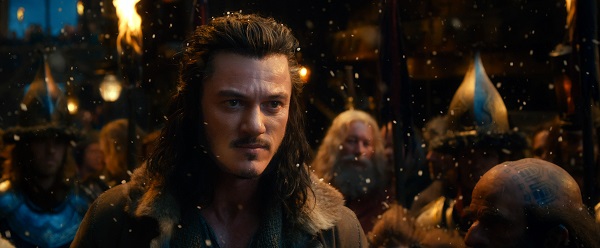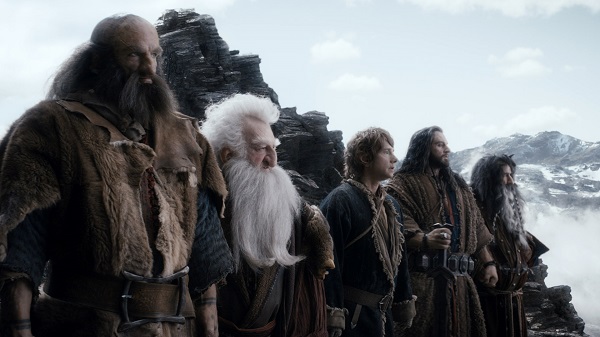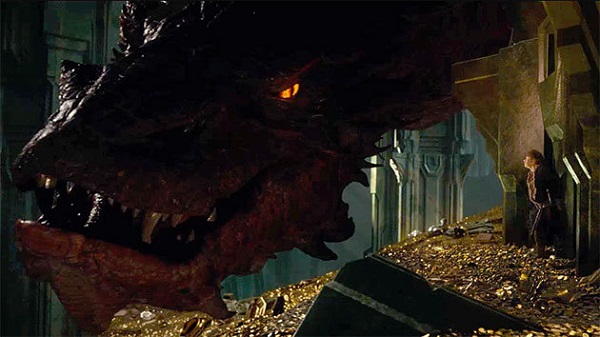The Hobbit: The Desolation of Smaug Review: The Return of Darkness
The first entry of
The Hobbit trilogy was met with a mixed reaction by some, being too light, too comic and too long. The second film,
The Hobbit: The Desolation of Smaug is the shortest movie in the series, strives for a much darker tone and begins to weave many of the trilogies plot lines together.
Thorin (Richard Armitage), Bilbo (Martin Freeman) and the company of Dwarves continuing their quest to The Lonely Mountain, in order to defeat the dragon Smaug (Bendict Cumberbatch) and reclaim the throne of Erebor. On their perilous journey through Mirkwood, the company end up clashing with the Elves, led by King Thranduil (Lee Pace) and Bard the Bowman (Luke Evans) of Lake-town. These two characters are but a few that hinder their journey before the final day of Autumn. A creature known as The Necromancer (also Cumberbatch) is summoning Orcs to the ruins of Dol Guldur, forcing Gandalf (Ian McKellen) to also face the new threat.
 The Hobbit: The Desolation of Smaug
The Hobbit: The Desolation of Smaug is a movie that contains sub-plots galore. Outside the main plot, involving the Dwarves, Gandalf cleanses Dol Guldur, Thranduil attempts to shelter his people in his borders, the political rivalries between Bard and The Master of Lake-town (Stephen Fry), Bilbo suffering from the effects of The Ring, Tauriel (Evangeline Lilly), the Captain of the Thranduil, guards wanting the elves to face the Orc threat and a love triangle between Taureil, Thranduil's son Legolas (Orlando Bloom) and Kili the dwarf (Aiden Turner). That a is a lot to handle even for a movie that is 161 minutes long and for someone of Peter Jackson's previous experience in Middle Earth, some of the subplots get sidelined. The subplot involving Bilbo's corruption and hearing voices in his head is a presence at the beginning movie, but is ignored later on.
The Hobbit is short novel and straight adaptation would have been a 2 hour, 30 minute movie. To add to the movie the screenplay supplement with the use of appendixes in
The Lord of the Rings, some elements of the
Unfinished Tales collection of short stories and the filmmakers own creative license. Tauriel is an original character created solely for the movie and Legolas had no role in the timeline. The events in Lake-town were also greatly altered from the original novel.

Unlike previous entries in the
Lord of the Rings series
The Hobbit: The Desolation of Smaug is the first time we look at the North of Middle-Earth. The tensions and policies are explored and showing that the Elf kingdom is insular and does not want to get involved with the wider world and the people of Lake-town are divided. Anti-dwarf prejudice is touched on, as dwarves are seem as greedy, selfish and short-sighted and only one level above Orcs.
One of the big themes is greed and lust; both for wealth and power. There is physical manifestation with Bilbo starting to see himself and savagely killing a spider, the Master of Lake Town seeking wealth and power, leading to the mismanagement of the town, Smaug not wanting to give up any his ill gotten gains. Thorin also suffers from greed, which affect his judgement, his relationships with his comrades and is forewarned that he could end up like his grandfather.

There is plenty of energy in the movie's action sequences, the highlight being the river chase as the Orcs, Dwarves and Elves are in a battle, filled with decapitations and arrows to Orcs' heads. Both Legolas and Tauriel are given plenty of chances to show their action credentials, though since this is a prequel we know that Legolas is immune from any perky incidents like an axe to the head. The final battle with Smaug is also ramped up from the book, giving Bilbo and the Dwarves a larger role.
The first act and the third act are great with its pacing, action and character development. Its the middle of the movie that
The Desolation of Smaug slows down, a little too much. This is the case of the events in Lake-town as the Dwarves try to prepare for the final leg of their journey. It is at this point when Bilbo does not have much of a presence in his own movie.

The Dwarves are give more chance to shine this time role. In the first
Hobbit movie, Ken Stott and James Nesbit were the Dwarves with the most screentime: in the sequel Graham McTavish as Dwalin was more noticeable with his aggression, Kili is given a background and even the silent Bombur (Stephen Hunter) is shown to be very strong despite his weight problem.
The Hobbit: Desolation of Smaug will give fans their Middle-Earth and is successful at solving some of the issues of the first
Hobbit movie. The tone is darker and the action is much less cartoony.
The Hobbit is proof of being the pinnacle of the fantasy genre and this second film still proves that.
Pros
- Excellent special effects and action
- A darker tone
- The Dwarves are give more time to shine
Cons
- A saggy middle
- A lack of Gandalf
- The 48fps format makes the movie looks it is going at double speed
 The Hobbit: The Desolation of Smaug is a movie that contains sub-plots galore. Outside the main plot, involving the Dwarves, Gandalf cleanses Dol Guldur, Thranduil attempts to shelter his people in his borders, the political rivalries between Bard and The Master of Lake-town (Stephen Fry), Bilbo suffering from the effects of The Ring, Tauriel (Evangeline Lilly), the Captain of the Thranduil, guards wanting the elves to face the Orc threat and a love triangle between Taureil, Thranduil's son Legolas (Orlando Bloom) and Kili the dwarf (Aiden Turner). That a is a lot to handle even for a movie that is 161 minutes long and for someone of Peter Jackson's previous experience in Middle Earth, some of the subplots get sidelined. The subplot involving Bilbo's corruption and hearing voices in his head is a presence at the beginning movie, but is ignored later on.
The Hobbit is short novel and straight adaptation would have been a 2 hour, 30 minute movie. To add to the movie the screenplay supplement with the use of appendixes in The Lord of the Rings, some elements of the Unfinished Tales collection of short stories and the filmmakers own creative license. Tauriel is an original character created solely for the movie and Legolas had no role in the timeline. The events in Lake-town were also greatly altered from the original novel.
The Hobbit: The Desolation of Smaug is a movie that contains sub-plots galore. Outside the main plot, involving the Dwarves, Gandalf cleanses Dol Guldur, Thranduil attempts to shelter his people in his borders, the political rivalries between Bard and The Master of Lake-town (Stephen Fry), Bilbo suffering from the effects of The Ring, Tauriel (Evangeline Lilly), the Captain of the Thranduil, guards wanting the elves to face the Orc threat and a love triangle between Taureil, Thranduil's son Legolas (Orlando Bloom) and Kili the dwarf (Aiden Turner). That a is a lot to handle even for a movie that is 161 minutes long and for someone of Peter Jackson's previous experience in Middle Earth, some of the subplots get sidelined. The subplot involving Bilbo's corruption and hearing voices in his head is a presence at the beginning movie, but is ignored later on.
The Hobbit is short novel and straight adaptation would have been a 2 hour, 30 minute movie. To add to the movie the screenplay supplement with the use of appendixes in The Lord of the Rings, some elements of the Unfinished Tales collection of short stories and the filmmakers own creative license. Tauriel is an original character created solely for the movie and Legolas had no role in the timeline. The events in Lake-town were also greatly altered from the original novel.
 Unlike previous entries in the Lord of the Rings series The Hobbit: The Desolation of Smaug is the first time we look at the North of Middle-Earth. The tensions and policies are explored and showing that the Elf kingdom is insular and does not want to get involved with the wider world and the people of Lake-town are divided. Anti-dwarf prejudice is touched on, as dwarves are seem as greedy, selfish and short-sighted and only one level above Orcs.
One of the big themes is greed and lust; both for wealth and power. There is physical manifestation with Bilbo starting to see himself and savagely killing a spider, the Master of Lake Town seeking wealth and power, leading to the mismanagement of the town, Smaug not wanting to give up any his ill gotten gains. Thorin also suffers from greed, which affect his judgement, his relationships with his comrades and is forewarned that he could end up like his grandfather.
Unlike previous entries in the Lord of the Rings series The Hobbit: The Desolation of Smaug is the first time we look at the North of Middle-Earth. The tensions and policies are explored and showing that the Elf kingdom is insular and does not want to get involved with the wider world and the people of Lake-town are divided. Anti-dwarf prejudice is touched on, as dwarves are seem as greedy, selfish and short-sighted and only one level above Orcs.
One of the big themes is greed and lust; both for wealth and power. There is physical manifestation with Bilbo starting to see himself and savagely killing a spider, the Master of Lake Town seeking wealth and power, leading to the mismanagement of the town, Smaug not wanting to give up any his ill gotten gains. Thorin also suffers from greed, which affect his judgement, his relationships with his comrades and is forewarned that he could end up like his grandfather.
 There is plenty of energy in the movie's action sequences, the highlight being the river chase as the Orcs, Dwarves and Elves are in a battle, filled with decapitations and arrows to Orcs' heads. Both Legolas and Tauriel are given plenty of chances to show their action credentials, though since this is a prequel we know that Legolas is immune from any perky incidents like an axe to the head. The final battle with Smaug is also ramped up from the book, giving Bilbo and the Dwarves a larger role.
The first act and the third act are great with its pacing, action and character development. Its the middle of the movie that The Desolation of Smaug slows down, a little too much. This is the case of the events in Lake-town as the Dwarves try to prepare for the final leg of their journey. It is at this point when Bilbo does not have much of a presence in his own movie.
There is plenty of energy in the movie's action sequences, the highlight being the river chase as the Orcs, Dwarves and Elves are in a battle, filled with decapitations and arrows to Orcs' heads. Both Legolas and Tauriel are given plenty of chances to show their action credentials, though since this is a prequel we know that Legolas is immune from any perky incidents like an axe to the head. The final battle with Smaug is also ramped up from the book, giving Bilbo and the Dwarves a larger role.
The first act and the third act are great with its pacing, action and character development. Its the middle of the movie that The Desolation of Smaug slows down, a little too much. This is the case of the events in Lake-town as the Dwarves try to prepare for the final leg of their journey. It is at this point when Bilbo does not have much of a presence in his own movie.
 The Dwarves are give more chance to shine this time role. In the first Hobbit movie, Ken Stott and James Nesbit were the Dwarves with the most screentime: in the sequel Graham McTavish as Dwalin was more noticeable with his aggression, Kili is given a background and even the silent Bombur (Stephen Hunter) is shown to be very strong despite his weight problem.
The Hobbit: Desolation of Smaug will give fans their Middle-Earth and is successful at solving some of the issues of the first Hobbit movie. The tone is darker and the action is much less cartoony. The Hobbit is proof of being the pinnacle of the fantasy genre and this second film still proves that.
The Dwarves are give more chance to shine this time role. In the first Hobbit movie, Ken Stott and James Nesbit were the Dwarves with the most screentime: in the sequel Graham McTavish as Dwalin was more noticeable with his aggression, Kili is given a background and even the silent Bombur (Stephen Hunter) is shown to be very strong despite his weight problem.
The Hobbit: Desolation of Smaug will give fans their Middle-Earth and is successful at solving some of the issues of the first Hobbit movie. The tone is darker and the action is much less cartoony. The Hobbit is proof of being the pinnacle of the fantasy genre and this second film still proves that.